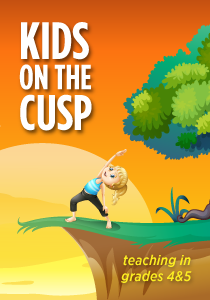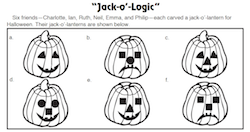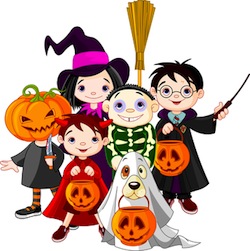A Halloween Teacher’s Self Evaluation
A MiddleWeb Blog
 Earlier our Kids on the Cusp blogger Mary Tarashuk took a break from her series of reflections on New Jersey’s new teacher self-assessment rubrics to share a different take on personal performance. We enjoyed it so much we thought we’d share it again this year – in advance of the popular holiday!
Earlier our Kids on the Cusp blogger Mary Tarashuk took a break from her series of reflections on New Jersey’s new teacher self-assessment rubrics to share a different take on personal performance. We enjoyed it so much we thought we’d share it again this year – in advance of the popular holiday!
Halloween was more than a week ago. I am still recovering. Dia de Los Muertos is a multi-faceted kind of day in elementary education. It’s not all about sugar, but sugar anticipation is in the air…and eventually, the sugar wears off. I am referring to myself, of course. Halloween candy has become a Tarashuk food group in the days following the school-wide celebration.
Our first round of parent-teacher conferences follows Halloween every year. This year, I have 23 kids. Each conference takes about a half an hour – some tougher ones a bit longer. The candy helps on the nights when we have evening conferences to accommodate working parents. (My daughter’s teacher scheduled ours for 7:50 a.m. to accommodate my teaching schedule. It’s what we do. Come to think of it, I should have brought him some candy…)
But first there’s The Day . . .

Even so, every child in my class wore a costume this year, and each had a raised energy level upon arrival on Halloween morning. From a teaching standpoint, I know there are some teachable moments to fill before the annual Halloween parade, which begins at approximately 1 p.m. The kids know that too. They also know, in a few hours, they will be scampering through the neighborhood begging for candy, flashlights in hand.
It’s 8:30 a.m. on a school day. But the reality is, it’s Halloween. The curriculum isn’t my focus on October 31st. It’s a day that calls for the trick-or-treat style of teaching. I choose the “trick.”
The objectives are not clearly posted for students to see. That goes out the window on All Hallow’s Eve. This doesn’t mean good learning can’t be present, though. I just try not to let the kids know that we are doing “work.” They don’t want to hear it on Halloween. I simply trick ‘em into learning something new.
Jack ‘o Logic Board
This year, I used an old stand-by. It’s a sample logic problem I found at least a decade ago called “Jack ‘o Logic.” A scanner and a Promethean Board helped introduce a logic grid (and the idea of logic in general). They were distracted from the afternoon parade as we began to “not work” at school.

“Jack ‘o Logic” is an activity I found on a previous Halloween in The Mailbox or another teacher magazine somewhere back in time. It engaged my students then and has continued to do so throughout the years. New isn’t always better.
The use of an interactive board is something new for me, but I am feeling more comfortable with this form of technology as I progress. Still, I’m a novice and I don’t put on an expert mask with my kids and pretend I know what I’m doing. They are often much better at manipulating today’s technology than I am. They do get a kick out of my not knowing exactly what I’m doing. (Always!)
A variety of student commentary is provided as an aid to my understanding and effectiveness, and to poke fun. They laugh at me en masse when I hit the wrong command. They enjoy my learning curve, and I know we’re laughing with each other as we try to blend old-school teaching methods with new opportunities to embrace technology.
Storytelling’s in my skill set

As this story of a gravedigger unfolds, we find that he has stolen gold coins from a woman he was supposed to bury. She comes looking for them. As I read, I slowly lean forward, extending my hand in a blind search for my stolen gold coins. Suddenly, she screams, and with a sudden lunge, close to 23 shrieks escape, as many of those huddled on the rug jump back in fright.
I know I didn’t really scare them. I surprised them with my sudden movement and my dramatic change in tone and volume level. But that’s a form of story-telling that enhances our Halloween experience. Common Core? It serves as a model for good reading, use of voice inflection, and assistance in making text-to-scream connections. After the fright interlude, we burst into laughter and popped the lights back on.
Acceptable levels of lunacy
After a quick history discussion about our celebration of this ancient Celtic tradition, the modern tradition of our schoolwide Halloween Sing-Along commenced. This annual event offers an opportunity to keep the haunted hype going within an atmosphere of controlled chaos. It can be fun, but the teacher in me must remain ever-vigilant, monitoring behavior and maintaining an acceptable level of lunacy. The lunch dismissal bell is a welcome sound in years when the balance of bedlam and order gets slightly off-kilter.

After numerous intercom announcements, alerting us to up-to-the-minute information regarding the status of the parade, the rain stopped. The parade would go on; albeit not exactly as planned (this seems to be an ongoing theme in teaching).
Once the flashbulbs and the paparazzi thinned, we returned to our room to “bob for donuts.” This involves tying donuts to strings and attempting to eat these swinging sweets. Kids with their hands held behind their backs, happily being bumped in the face by orange iced donuts, is a sight to be seen. They were craning their necks to attack their sugary prizes from a new angle (this activity improves flexibility and eye-mouth coordination in young learners).
Belly-laughing on Halloween really should be a required standard in schools. Maybe we can learn a lesson from a day without any “real” schoolwork.
Aftermath
Mystery and fun can be in our classrooms long after Halloween has passed, if we remember to keep the spirit of learning and laughter alive. But parent-teacher conferences need to be held. The holiday masks must come off, and the process of learning and assessing student growth must continue. Student progress must be discussed. That’s okay. I’ll get through it. I have a candy bar or two stuffed in my desk, in case of emergency.



































Love your writing style. So engaging. Well done. “Acceptable levels of lunacy” and “text to scream”. You are a scream!!
Thank you, Mr. P!…days like Halloween help me remember the need for lunacy…and it seems to be a job requirement in education!